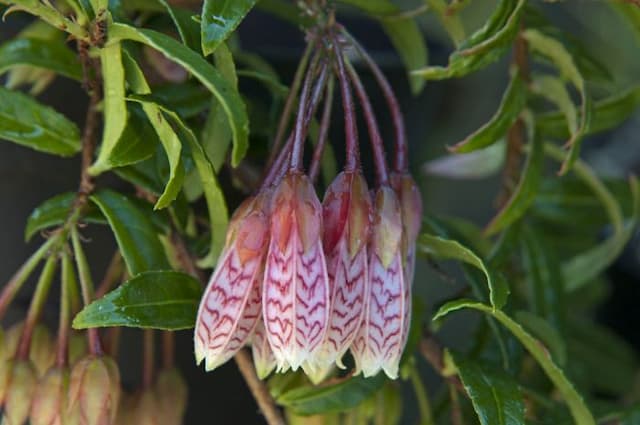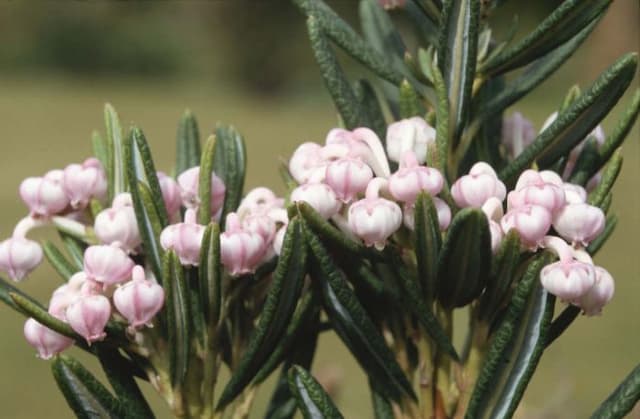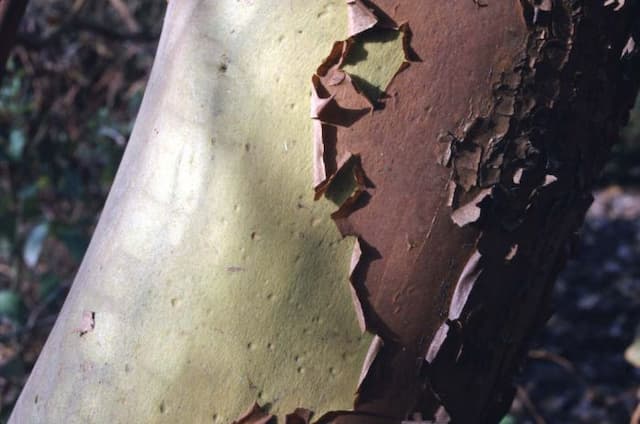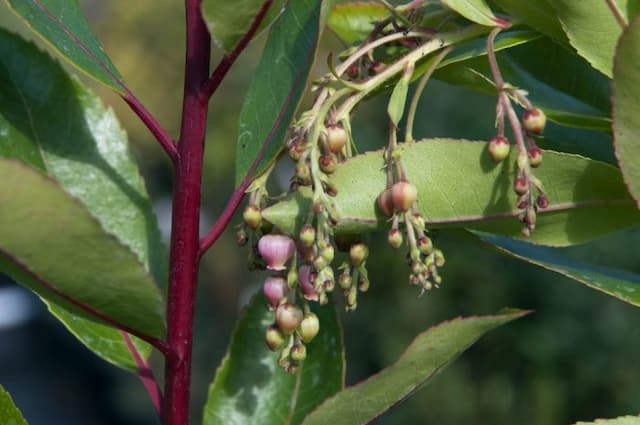Bog Rosemary Andromeda polifolia 'Macrophylla'

ABOUT
The plant commonly known as Bog Rosemary 'Macrophylla' is a compact evergreen shrub. Distinguished by its narrow, leathery leaves, similar in appearance to the herb rosemary, they are a striking blue-green hue on top with a white or silvery underside, creating a beautiful color contrast that catches the eye. The leaves are quite small and are oriented in an alternating fashion along the stems, providing a delicate texture to the plant's structure. During spring, the Bog Rosemary 'Macrophylla' produces clusters of small, bell-shaped flowers that can range from pink to a pale purplish-pink color. These flowers dangle at the tips of the branches, adding a soft, romantic aesthetic to the plant. The visual appeal of these blossoms is heightened by their gentle nodding habit, making them seem as though they're delicately poised to drop. As a broadleaf evergreen, this plant offers year-round visual interest. The leathery foliage and the plant's overall form contribute to an appealing structure in the garden, providing texture and color in all seasons. Its evergreen nature means the blue-green leaves remain present even when many other plants have lost their foliage or are dormant, maintaining the visual appeal of the space it occupies. Overall, the Bog Rosemary 'Macrophylla' is noted for its unique foliar coloration, the charming form of its leaves, and its pretty, pendulous spring flowers that can draw the attention of onlookers and add softness to the surrounding garden landscape.
About this plant
 Names
NamesFamily
Ericaceae.
Synonyms
Bog Rosemary, Marsh Andromeda.
Common names
Andromeda polifolia var. macrophylla, Andromeda macrophylla.
 Toxicity
ToxicityTo humans
Bog rosemary, Andromeda polifolia 'Macrophylla', is toxic to humans. If ingested, the plant contains grayanotoxins that can lead to symptoms such as vomiting, diarrhea, abdominal pain, and in severe cases, cardiovascular problems like low blood pressure and arrhythmias. Handling the plant might cause skin irritation in sensitive individuals.
To pets
Bog rosemary, Andromeda polifolia 'Macrophylla', is toxic to pets. If ingested by animals such as dogs or cats, the plant can cause similar symptoms to those in humans, including vomiting, diarrhea, drooling, weakness, and potentially, cardiac issues. The grayanotoxins in the plant affect the sodium channels in the cell membranes, which can lead to a range of symptoms from gastrointestinal upset to life-threatening heart rhythm disturbances.
 Characteristics
CharacteristicsLife cycle
Perennials
Foliage type
Evergreen
Color of leaves
Blue-green
Flower color
Pink
Height
1-2 feet (30-60 cm)
Spread
1-3 feet (30-90 cm)
Plant type
Shrub
Hardiness zones
2
Native area
Northern Hemisphere
Benefits
 General Benefits
General Benefits- Aesthetic Appeal: Adds a unique texture and color to gardens with its large leaves and pink springtime blooms.
- Wildlife Habitat: Acts as a food source and habitat for wildlife, particularly attracting butterflies and bees.
- Low Maintenance: Once established, it requires minimal care, making it suitable for gardeners at all skill levels.
- Cold Tolerant: Withstands cold temperatures, making it ideal for cooler climates and regions with harsh winters.
- Evergreen: Maintains foliage throughout the year, providing constant interest in the landscape.
- Bog Garden Plant: Well-suited for bog gardens or areas with moist, acidic soil, enhancing waterlogged garden spaces.
- Erosion Control: Helps prevent soil erosion in sloped areas or near water sources with its root system.
 Medical Properties
Medical PropertiesThis plant is not used for medical purposes.
 Air-purifying Qualities
Air-purifying QualitiesThis plant is not specifically known for air purifying qualities.
 Other Uses
Other Uses- Crafting Bonsai: Andromeda can be trained into miniature form, making a unique bonsai that stands out for its evergreen foliage and potential to bloom even when dwarfed.
- Dye Production: Historically, the leaves of Andromeda may have been used for making green dyes for fabrics or crafts.
- Nature Photography: With its distinctive foliage and flowers, Andromeda provides photographers with a unique subject for nature and macro photography.
- Theme Gardens: Andromeda is an excellent addition to theme gardens, such as 'Alice in Wonderland' or fantasy gardens, due to its whimsical appearance.
- Floral Arrangements: The branches and flowers of Andromeda can be used in floral arrangements, especially in winter when options are limited.
- Educational Tool: Andromeda plants can be used in schools or educational programs to teach botany, specifically the adaptation of plants to acidic soils.
- Fragrance Extraction: While not common, the flowers of Andromeda polifolia may be used in the production of perfumes or scents.
- Winter Garden Interest: With its resistance to cold and evergreen leaves, Andromeda adds visual interest to gardens during the drab winter months.
- Rain Gardens: Andromeda can be planted in rain gardens where its tolerance for boggy soils can be an advantage.
- Culinary Garnish: Though not a common practice, the flowers and foliage could be used as a non-toxic garnish for culinary dishes for special occasions.
Interesting Facts
 Feng Shui
Feng ShuiThe Bog Rosemary is not used in Feng Shui practice.
 Zodiac Sign Compitability
Zodiac Sign CompitabilityThe Bog Rosemary is not used in astrology practice.
 Plant Symbolism
Plant Symbolism- Protection - Being named after the Greek mythological princess Andromeda, who was chained to a rock as a sacrifice to a sea monster, Andromeda polifolia can represent protection from harm and danger, as Perseus saved Andromeda.
- Endurance and Survival - This plant is known for its ability to survive in cold boggy conditions, making it a symbol of endurance and the ability to thrive in challenging environments.
- Purity - The color of its flowers, often a shade of light pink to white, symbolizes purity and innocence, similar to the character of Andromeda in mythology.
- Beauty and Femininity - Andromeda polifolia, with its delicate floral appearance, can be associated with beauty and the softer aspects of femininity, again drawing a parallel to the princess Andromeda's grace and poise.
 Water
WaterBog rosemary should be watered regularly to maintain consistently moist soil, especially during its growing season in spring and summer. Typically, it's recommended to provide about 1 inch of water per week, either through rainfall or manual watering. In drier conditions, this may require up to 2 gallons per week for an established plant, but always check the soil before watering to ensure it hasn't become waterlogged. In winter, reduce watering but do not allow the soil to completely dry out.
 Light
LightBog rosemary thrives best in full sun to partial shade. It is recommended to place it in a spot where it can receive at least four to six hours of sunlight daily. Too much shade can lead to leggy growth and fewer flowers, whereas too much direct sun, especially in hotter climates, may scorch its leaves.
 Temperature
TemperatureBog rosemary prefers cool temperatures and can generally tolerate temperatures down to about -30°F, but it thrives in temperatures ranging from 60°F to 70°F during the growing season. It is not well-suited to hot climates where temperatures frequently exceed 75°F, as excessive heat can damage the plant.
 Pruning
PruningPruning bog rosemary is generally done to maintain its shape and encourage bushier growth. The best time to prune is in late winter or early spring before new growth starts. Prune sparingly, removing only dead or damaged branches, and occasionally shape the plant if necessary. Pruning is not required annually; it can be done every other year or as needed to keep the plant tidy.
 Cleaning
CleaningAs needed
 Soil
SoilThe Bog Rosemary, Andromeda polifolia 'Macrophylla', thrives in an acidic soil mix with a pH of 4.5 to 5.5. A good soil mixture for this plant would be composed of peat moss, pine bark, and perlite or sand to ensure adequate drainage and retain the necessary moisture. Regularly check the soil's acidity and adjust as needed, since the Bog Rosemary prefers strongly acidic conditions.
 Repotting
RepottingThe Bog Rosemary (Andromeda polifolia 'Macrophylla') should be repotted every 2 to 3 years to refresh the soil and accommodate root growth. Choose a pot only slightly larger than the previous one to prevent waterlogging the roots, and ensure the new pot has good drainage.
 Humidity & Misting
Humidity & MistingBog Rosemary (Andromeda polifolia 'Macrophylla') prefers high humidity levels typically above 50%. It thrives in a moist environment similar to its natural bog habitat, so maintaining a higher humidity around the plant is beneficial. Avoid placing it in excessively dry rooms or near heating vents.
 Suitable locations
Suitable locationsIndoor
Place in bright, indirect light and ensure high humidity for Bog Rosemary.
Outdoor
Plant in acidic soil with partial shade and protect from strong winds.
Hardiness zone
2-6 USDA
 Life cycle
Life cycleAndromeda polifolia 'Macrophylla', commonly known as Bog rosemary, initiates its life cycle with seed germination, occurring in moist, acidic soil typical of bogs and wetlands. Seedlings develop into juvenile plants with the formation of a rosette of leaves, gradually maturing and developing a woody stem characteristic of this dwarf shrub. As the plant reaches maturity, it produces small, bell-shaped pink to white flowers in spring, which are pollinated by insects, leading to the development of capsule-like fruit containing numerous seeds. After seed dispersal, the plant enters a period of vegetative growth where it expands in size and may spread through rhizomes. In its mature phase, Bog rosemary will experience cycles of flowering and seed production annually, adapting to the cold conditions of its natural habitat. This evergreen perennial can live for many years, surviving harsh winters with its foliage intact until it eventually succumbs to natural senescence.
 Propogation
PropogationPropogation time
Spring to Summer
Propogation: The most popular method of propagation for Andromeda polifolia 'Macrophylla', commonly known as Bog Rosemary, is by semi-ripe cuttings. The best time to do this is in the late summer, around late July to early September. To propagate successfully, take semi-ripe cuttings about 4 to 6 inches (approximately 10 to 15 centimeters) in length from healthy, disease-free plants. Remove the lower leaves, dip the cut end in a rooting hormone powder to enhance root growth, and then insert the cutting in a well-draining rooting medium. Provide the cuttings with consistent moisture without waterlogging and keep them in a warm, shaded environment until roots are established, after which they can be potted up or planted out.









